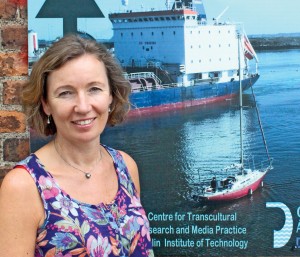
A two-week free audio visual exhibition hit the Dublin docklands on July 1st. Rhythms of a Port opened in the Red Brick Shed on John Rogerson’s Quay and is a production by Dublin-based artist and filmmaker Moira Sweeney, pictured above, in association with Dublin Port Company. The exhibition is part of the Photo Ireland Festival 2014.
Rhythms of a Port tells the story of Dublin’s Docklands and attempts to illustrate the intimate connection between the docks and the surrounding city areas. The documentary combines the personal tales of dock workers past and present with Sweeney’s unique modern style.
The Red Shed was formerly known as the Old London Shed, an integral historical structure in the Docklands legacy, making it an ideal setting for the exhibition. By hanging large screens from the rafters displaying the tales of the port’s dock workers, boatmen and managers, Sweeney transforms the old dry cargo storehouse into a living and breathing exhibition.
Visitors are treated to visuals of Sweeney’s striking photography accompanied by the sounds one would expect to hear at a working port, including forklift warnings, creaking wood and metal, squeaking ropes and squawking seagulls.
The launch on July 1st welcomed a multitude of revellers, consisting mainly of dock workers, local artists and representatives from Dublin Port Company.
Dublin Port Company Chief Executive Eamon O’ Reilly emphasised the timely significance of the exhibition, given the rich historical importance of the Dublin Docklands area.
“The Docklands is an integral Dublin institution, and one close to the hearts of all Dubliners,” he told NewsFour. “The Rhythms of a Port exhibition sheds new light on one of our oldest and most bustling city quarters, and aims to educate and challenge its audience on the Port’s special relationship with Dublin and the workers who have served it so well.”
This is Sweeney’s second exhibition for Photo Ireland; the previous one was held in 2012. She is the recipient of a PhD from the Centre for Transcultural Research and Media Practice in the Dublin Institute of Technology, a scholarship that allowed her to commit to the study in the first place. Her work has been exhibited abroad in cities as far-flung as London, Melbourne, Berlin and Edinburgh, and she has also produced documentaries for BBC, Channel 4, RTE, TG4 and ZDF.
Sweeney spoke to NewsFour about her reasons for producing the documentary, as port life is something that often goes unnoticed by the general public.
“It allows people to see something of port life, working dock life,” she told us. “It’s a temporary setting in a space that doesn’t get used at the moment; it’s a way of celebrating the heritage of the port and making it accessible to people.”
Sweeney also underscored the importance of the docklands with regard to local areas, given the history of the port labour forces in those areas.
“All of the dockers in the film, at one point of their life, lived close to the docks or their parents: most of their parents worked on the docks, and their grandparents,” she stated. “They mostly lived in Sheriff Street, the North Wall, Ringsend or East Wall, so there was that connection and that’s very strong.”
By Craig Kinsella



